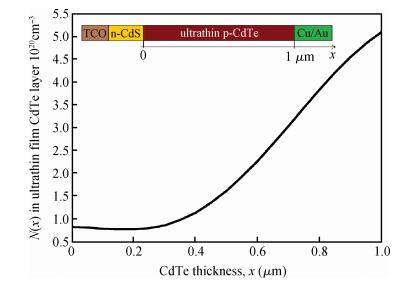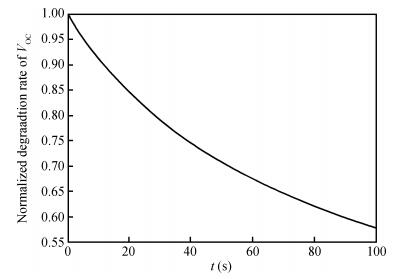| Citation: |
Nima E. Gorji. Modeling the defect distribution and degradation of CdTe ultrathin films[J]. Journal of Semiconductors, 2014, 35(12): 122001. doi: 10.1088/1674-4926/35/12/122001
****
N. E. Gorji. Modeling the defect distribution and degradation of CdTe ultrathin films[J]. J. Semicond., 2014, 35(12): 122001. doi: 10.1088/1674-4926/35/12/122001.
|
Modeling the defect distribution and degradation of CdTe ultrathin films
DOI: 10.1088/1674-4926/35/12/122001
More Information
-
Abstract
The defect distribution across an ultrathin film CdTe layer of a CdS/CdTe solar cell is modelled by solving the balance equation in steady state. The degradation of the device parameters, because of the defect induced through ion implantation, was considered. The degradation is accelerated if the ion implanted defect distribution is considerable. The defect concentration is maximum at the surface of the CdTe layer where implantation is applied and it is minimum at the junction with the CdS layer (CdS/CdTe). The ultrathin device is under exposure of a fast degradation if the defect concentration is high at the junction. Since the front and back contacts of the device are close and the electric field is strong to drive the defects into the junction, the p-doping process might be precisely controlled. The modeling results presented here are in agreement with the few available experimental reports in the literature on the degradation and defect configuration of the ultrathin CdTe films.-
Keywords:
- defect distribution,
- ultrathin films,
- CdTe,
- degradation,
- ion implantation
-
References
[1] Paudel N, Wieland K A, Young M, et al. Stability of sub-micron-thick CdTe solar cells. Prog Photovolt:Res Appl, 2014, 22:107 doi: 10.1002/pip.v22.1[2] Plotnikov V. Fabrication of ultra-thin CdS/CdTe solar cells by magnetron sputtering. Doctoral Thesis, University of Toledo, USA, 2009[3] Salavei A, RimmaudoI, Piccinelli F, et al. Influence of CdTe thickness on structural and electrical properties of CdTe/CdS solar cells. Thin Solid Films, 2013, 535:257 doi: 10.1016/j.tsf.2012.11.121[4] Kraft C, Bromel A, Schonherr S, et al. Phosphorus implanted cadmium telluride solar cells. Thin Solid Films, 2011, 519:7153 doi: 10.1016/j.tsf.2011.01.389[5] Nsengiyumva S, Raji A T, Riviere J P, et al. Stress enhanced diffusion of krypton ions in polycrystalline titanium. J Appl Phys, 2014, 116:023513 doi: 10.1063/1.4889818[6] Kosyachenko L, Toyama T. Current-voltage characteristics and quantum efficiency spectra of efficient thin-film CdS/CdTe solarcells. Sol Energy Mat & Sol Cells, 2014, 120:512[7] Gorji N E. Impact ionization effects on the efficiency of the intermediate band solar cells. Physica E, 2012, 44(7/8): 1608.[8] Gorji N E. Degradation sources of CdTe thin film PV:CdCl2 residue and shunting pinholes. Appl Phys A, 2014, 116(3):1347 doi: 10.1007/s00339-014-8232-7[9] Xosrovashvili G, Gorji N E. Numerical simulation of carbon nanotubes/GaAs hybrid PV devices with AMPS-1D. International Journal of Photoenergy, 2014: 784857[10] Shvydka D, Verzella C, Karpov V G, et al. Photoluminescence fatigue and related degradation in thin-film photovoltaics. J Appl Phys, 2003, 94(6):3901 doi: 10.1063/1.1601687[11] Harju R, Karpov V G, Grecu D, et al. Electron-beam induced degradation in CdTe photovoltaics. J Appl Phys, 2000, 88:1794 doi: 10.1063/1.1305857[12] Kosyachenko L A, Maslyanchuk O L, Sklyarchuk V M, et al. Electrical characteristics of Schottky diodes based on semi-insulating CdTe single crystals. J Appl Phys, 2007, 101:013704 doi: 10.1063/1.2401283[13] Kosyachenko L A, Maslyanchuk O L, Sklyarchuk V M. Special features of charge transport in Schottky diodes based on semi-insulating CdTe. Semiconductors, 2005, 39(6):722 doi: 10.1134/1.1944866[14] Hwang H L, Hsu K, Ueng H. Electron paramagnetic resonance study on annealing of phosphorus-implanted cadmium telluride. J Cryst Growth, 1996, 161:73 doi: 10.1016/0022-0248(95)00614-1[15] Gorji N E. Quantitative analysis of the optical losses in CZTS thin-film semiconductors. IEEE Trans Nanotechnol, 2014, 13(4):743 doi: 10.1109/TNANO.2014.2318057 -
Proportional views






 DownLoad:
DownLoad:
















